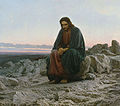
Matthew 4:2
Encyclopedia

Gospel of Matthew
The Gospel According to Matthew is one of the four canonical gospels, one of the three synoptic gospels, and the first book of the New Testament. It tells of the life, ministry, death, and resurrection of Jesus of Nazareth...
in the New Testament
New Testament
The New Testament is the second major division of the Christian biblical canon, the first such division being the much longer Old Testament....
. This verse is just preceding the section in Matthew dealing with the temptation
Temptation
A temptation is an act that looks appealing to an individual. It is usually used to describe acts with negative connotations and as such, tends to lead a person to regret such actions, for various reasons: legal, social, psychological , health, economic, etc...
of Christ
Christ
Christ is the English term for the Greek meaning "the anointed one". It is a translation of the Hebrew , usually transliterated into English as Messiah or Mashiach...
by Satan
Satan
Satan , "the opposer", is the title of various entities, both human and divine, who challenge the faith of humans in the Hebrew Bible...
. Jesus
Jesus
Jesus of Nazareth , commonly referred to as Jesus Christ or simply as Jesus or Christ, is the central figure of Christianity...
has been led out into the wilderness and in this verse he fasts.
In the King James Version of the Bible the text reads:
- And when he had fasted forty
- days and forty nights, he
- was afterward an hungred.
The World English Bible
World English Bible
The World English Bible is a public domain translation of the Bible that is currently in draft form. Work on the World English Bible began in 1997 and was known as the American Standard Version 1997...
translates the passage as:
- When he had fasted forty
- days and forty nights, he
- was hungry afterward.
For a collection of other versions see BibRef Matthew 4:2
Hill notes that traditionally fasting presaged a great spiritual struggle, as it does in this verse. The verse alludes to several Old Testament passages. Moses fasts for forty days and forty nights before writing the holy scripture, and Elijah in 1 Kings 19:8 travels for the same period without food. Matthew, unlike Luke, adds "and forty nights" more closely linking the passage to the Old Testament. Another important parallel is with the entire nation of Israel
Israel
The State of Israel is a parliamentary republic located in the Middle East, along the eastern shore of the Mediterranean Sea...
that spent forty years in the desert without much food after the Exodus
The Exodus
The Exodus is the story of the departure of the Israelites from ancient Egypt described in the Hebrew Bible.Narrowly defined, the term refers only to the departure from Egypt described in the Book of Exodus; more widely, it takes in the subsequent law-givings and wanderings in the wilderness...
. A popular theory is that the entire temptation narrative is meant to parallel the history of Israel. Clarke notes that at the time forty was less a specific number and more a general expression for any large figure.
France notes that fasting does not necessarily mean a complete abstinence from food and that Jesus may have been surviving on the sparse food that could be obtained in the desert. Mark does not mention this fasting and Luke implies it but does not use the word. Gundry notes that the author of Matthew seems to be a far more interested in this idea than the other evangelists, and in Matthew 6
Matthew 6
Matthew 6 is the sixth chapter of the Gospel of Matthew in the New Testament. This chapter contains the middle portion of the Sermon on the Mount. It includes the Lord's Prayer....
again seems to present fasting as a model for good behaviour. This fasting became the model for the practice of Lent
Lent
In the Christian tradition, Lent is the period of the liturgical year from Ash Wednesday to Easter. The traditional purpose of Lent is the preparation of the believer – through prayer, repentance, almsgiving and self-denial – for the annual commemoration during Holy Week of the Death and...
in the Roman Catholic and Eastern Orthodox churches, a ritual that lasts forty days, but is today a less than total abstinence. Protestants, in general, do not see this passage as a justification for Lent. Martin Luther
Martin Luther
Martin Luther was a German priest, professor of theology and iconic figure of the Protestant Reformation. He strongly disputed the claim that freedom from God's punishment for sin could be purchased with money. He confronted indulgence salesman Johann Tetzel with his Ninety-Five Theses in 1517...
felt the ritual was artificial, but useful in focusing the minds of the faithful. John Calvin
John Calvin
John Calvin was an influential French theologian and pastor during the Protestant Reformation. He was a principal figure in the development of the system of Christian theology later called Calvinism. Originally trained as a humanist lawyer, he broke from the Roman Catholic Church around 1530...
felt the entire notion was silly and that if imitating Jesus was truly the path to salvation then believers should be striving to walk on water or turn water to wine.

